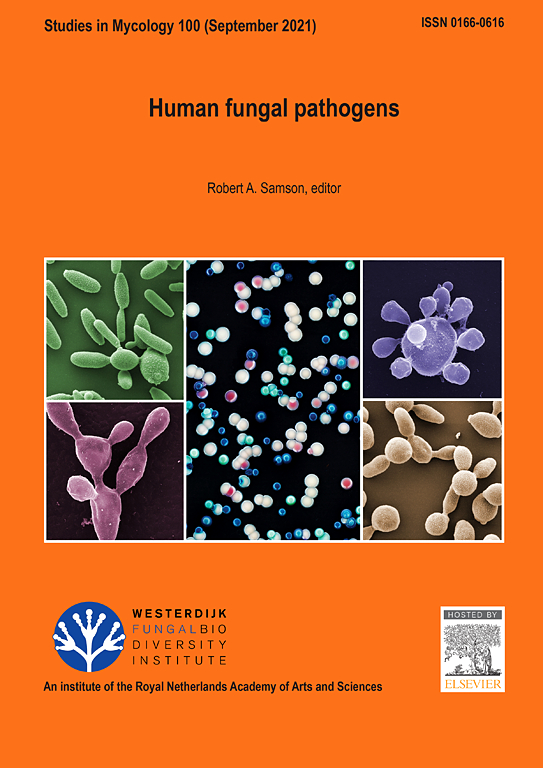sambucinum镰刀菌种复合体的综合再评价。
摘要
sambucinum Fusarium species complex (FSAMSC);镰刀菌(镰刀菌科,镰刀菌属)是众所周知的包括毁灭性的植物病原体和产毒物种。然而,这类喜草真菌也能容纳人类和其他动物的土壤样本、内生菌、支寄生虫和罕见的机会致病菌。尽管FSAMSC中有大量的分类群尚未被系统地描述,并且仍然缺乏拉丁二项分类,但最近的出版物强调了FSAMSC中巨大的系统发育和生化多样性。在这项研究中,我们基于5个基因区域(钙调素、RNA聚合酶II最大和第二大亚基、翻译延伸因子1-α和β-微管蛋白),采用形态学、多位点系统发育和聚结分析等综合方法,建立了FSAMSC的系统发育广度。结果支持FSAMSC对75个分类群的识别,包括目前已知的所有种属分离。30个新物种被正式描述和说明,而4个系统发育物种仍未被描述。本文通过形态学、系统发育学和交配实验等方法对最近收集的镰刀菌属(Fusarium, f.s ambucinum)进行鉴定,提出了镰刀菌属的一个表型,确定了该名称在系统发育学上的应用。另外还包括了关于谷类镰刀菌(同为谷类镰刀菌)的分类的注释。分类新异:新种:镰刀菌。J.Z.格林纽。& Crous,镰刀菌(Fusarium amblysporum)。M.M.科斯塔,香蕉镰刀菌沙登。M.M. Costa,镰刀菌沙-登。J.Z.格林纽。和克劳斯,镰刀菌短型沙-登。J.Z.格林纽。&克罗斯,镰刀菌砂-登。J.Z.格林纽。和克劳斯,镰刀菌培养沙-登。M.M. Costa,镰刀菌沙-登。J.Z.格林纽。& Crous,镰刀菌cygneum sand - den。J.Z.格林纽。和克劳斯,二磷镰刀菌沙-登。, M.M.科斯塔,J.Z.格林纽。& Crous,镰刀菌(Fusarium dolichosporum sand - den)。J.Z.格林纽。&克罗斯,剑兰镰刀菌沙-登。J.Z.格林纽。& crows,镰刀菌hamatum sand - den。, M.M.科斯塔,J.Z.格林纽。& Crous,镰刀菌;J.Z.格林纽。& Crous,镰刀菌(Fusarium longicolle sand - den)。J.Z.格林纽。& Crous,镰刀菌magnum sand - den。J.Z.格林纽。& Crous, mastigosporum sand . den。, M.M.科斯塔,J.Z.格林纽。& Crous,镰刀菌(Fusarium minutum sand - den)。J.Z.格林纽。& Crous,镰刀菌沙-登。J.Z.格林纽。和克劳斯,镰刀菌抛物线沙-登。J.Z.格林纽。& Crous, platysporum sand . den。J.Z.格林纽。& Crous,镰刀菌pratense sand - den。J.Z.格林纽。& Crous,镰刀菌(Fusarium procumbens sand - den)。J.Z.格林纽。& Crous, pseudolongipes sand - den。J.Z.格林纽。&克罗斯,矢状镰刀菌沙-登。J.Z.格林纽。& Crous,镰刀菌(Fusarium secliformme sand . den)。J.Z.格林纽。和克罗斯,镰刀菌亚圆柱体。J.Z.格林纽。和克罗斯,对称镰刀菌沙-登。J.Z.格林纽。& Crous,热带镰刀菌沙-登。, M.M.科斯塔,J.Z.格林纽。和克劳斯,蛭状镰刀菌。J.Z.格林纽。& Crous。类型:镰刀菌(Fusarium sambucinum Fuckel)引用本文:Sandoval-Denis M, Costa MM, Broders K, Becker Y, Maier W, Yurkov A, Kermode A, Buddie AG, Ryan MJ, Schumacher RK, Groenewald JZ, Crous PW(2024)。sambucinum镰刀菌种复合体的综合再评价。真菌学研究110:1-110 doi: 10.3114/sim.2025.110.01。The species-rich Fusarium sambucinum species complex (FSAMSC; Fusarium, Nectriaceae, Hypocreales) is well-known for including devastating plant pathogens and toxigenic species. However, this group of grass-loving fungi also accommodates soil saprobes, endophytes, mycoparasites and rare opportunistic pathogens of humans and other animals. Recent publications have highlighted the vast phylogenetic and biochemical diversity of the FSAMSC, although a large number of taxa in FSAMSC have not been systematically described and still lack Latin binomials. In this study we established the phylogenetic breadth of the FSAMSC using an integrative approach including morphological, multilocus phylogenetic, and coalescence analyses based on five gene regions (calmodulin, RNA polymerase II largest and second largest subunits, translation elongation factor 1-α, and β-tubulin). Results obtained support the recognition of 75 taxa in FSAMSC, including all the currently known species segregates of the Fusarium head-blight pathogen F. graminearum s. lat. Thirty novel species are formally described and illustrated, while four phylogenetic species remain undescribed. An epitype is proposed for the generic type of Fusarium, F. sambucinum, from recently collected material identified by means of morphology, phylogenetics and mating experiments, fixing the phylogenetic application of the name. Additional notes are included on the typification of Fusisporium cerealis (syn. Fusarium cerealis). Taxonomic novelties: New species: Fusarium agreste Sand.-Den., J.Z. Groenew. & Crous, Fusarium amblysporum Sand.-Den., M.M. Costa, Fusarium bananae Sand.-Den., M.M. Costa, Fusarium bellum Sand.-Den., J.Z. Groenew. & Crous, Fusarium brachypes Sand.-Den., J.Z. Groenew. & Crous, Fusarium carinatum Sand.-Den., J.Z. Groenew. & Crous, Fusarium cultriforme Sand.-Den., M.M. Costa, Fusarium cuspidatum Sand.-Den., J.Z. Groenew. & Crous, Fusarium cygneum Sand.-Den., J.Z. Groenew. & Crous, Fusarium dimorphosporum Sand.-Den., M.M. Costa, J.Z. Groenew. & Crous, Fusarium dolichosporum Sand.-Den., J.Z. Groenew. & Crous, Fusarium gladiolum Sand.-Den., J.Z. Groenew. & Crous, Fusarium hamatum Sand.-Den., M.M. Costa, J.Z. Groenew. & Crous, Fusarium leptum Sand.-Den., J.Z. Groenew. & Crous, Fusarium longicolle Sand.-Den., J.Z. Groenew. & Crous, Fusarium magnum Sand.-Den., J.Z. Groenew. & Crous, Fusarium mastigosporum Sand.-Den., M.M. Costa, J.Z. Groenew. & Crous, Fusarium minutum Sand.-Den., J.Z. Groenew. & Crous, Fusarium mucronatum Sand.-Den., J.Z. Groenew. & Crous, Fusarium parabolicum Sand.-Den., J.Z. Groenew. & Crous, Fusarium platysporum Sand.-Den., J.Z. Groenew. & Crous, Fusarium pratense Sand.-Den., J.Z. Groenew. & Crous, Fusarium procumbens Sand.-Den., J.Z. Groenew. & Crous, Fusarium pseudolongipes Sand.-Den., J.Z. Groenew. & Crous, Fusarium sagittatum Sand.-Den., J.Z. Groenew. & Crous, Fusarium seculiforme Sand.-Den., J.Z. Groenew. & Crous, Fusarium subcylindroides Sand.-Den., J.Z. Groenew. & Crous, Fusarium symmetricum Sand.-Den., J.Z. Groenew. & Crous, Fusarium tropicale Sand.-Den., M.M. Costa, J.Z. Groenew. & Crous, Fusarium vermicularioides Sand.-Den., J.Z. Groenew. & Crous. Epitype: Fusarium sambucinum Fuckel. Citation: Sandoval-Denis M, Costa MM, Broders K, Becker Y, Maier W, Yurkov A, Kermode A, Buddie AG, Ryan MJ, Schumacher RK, Groenewald JZ, Crous PW (2024). An integrative re-evaluation of the Fusarium sambucinum species complex. Studies in Mycology 110: 1-110 doi: 10.3114/sim.2025.110.01.

 求助内容:
求助内容: 应助结果提醒方式:
应助结果提醒方式:


